In continuation with the previous article, Model Analysis in Fluid Mechanics helps predict the performance of these hydraulic structures or hydraulic machines before actually constructing or manufacturing. Model law helps identify the dynamic similarities between the model and the prototype. Let us discuss more details on different Model Laws in Fluid Dynamics.
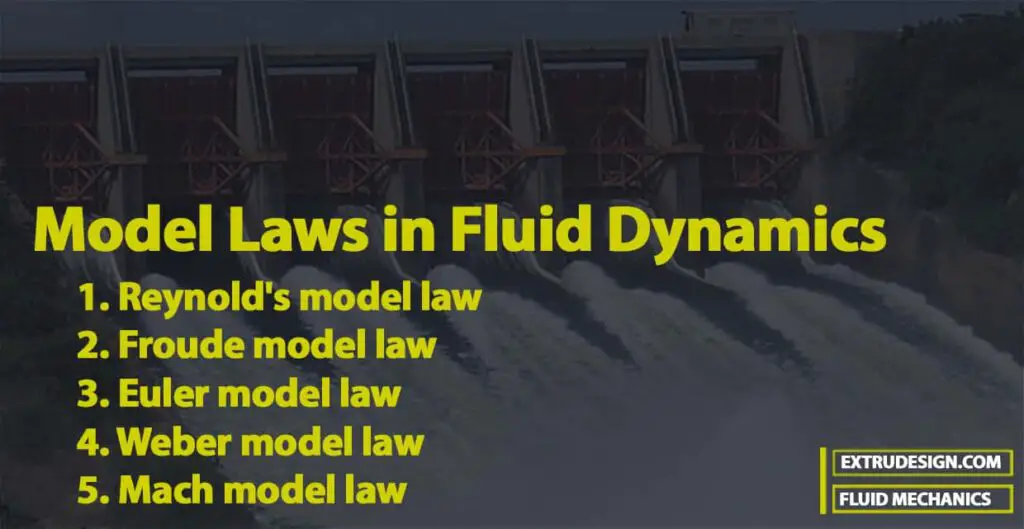
Dimensional Analysis and Model Analysis are two important tools to help engineers to build structures or machines which involve hydraulic fluid. Model analysis especially helps predict the performance of these hydraulic structures (such as dams, spillways etc.) or hydraulic machines (such as turbines, pumps etc.), before actually constructing or manufacturing. Models of the structures or machines are made and tests are performed on them to obtain the desired information.
What is a Model?
The model is a small-scale replica of the actual structure or machine.
What is a prototype?
The actual structure or machine is called Prototype. It is not necessary that the models should be smaller than the prototypes (though in most cases it is), they may be larger than the prototype.
The study of models of actual machines is called Model analysis. Model analysis is actually an experimental method of finding solutions to complex flow problems. Firstly, the model analysis purpose is to obtain information about the likely performance of the prototype. Secondly, to help in the design and avoid costly mistakes and evolve an economic solution to a hydraulic problem.
Before we get started with the Model laws, we need to understand the basics of Dimensionless numbers.
Dimensionless Numbers
Dimensionless numbers are those numbers which are obtained by dividing the inertia force by viscous force or gravity force or pressure force or surface tension force or elastic force. As this is a ratio of one force to the other force, it will be a dimensionless number. These dimensionless numbers are also called non-dimensional parameters.
The followings are the important dimensionless numbers:
- Reynold’s number
- Froude’s number
- Euler’s number
- Weber’s number
- Mach’s number
1. Reynold’s Number (Re)
It is defined as the ratio of the inertia force of a flowing fluid and the viscous force of the fluid. The expression for Reynold’s number is obtained as
Inertia force (Fi) = Mass × Acceleration of flowing fluid
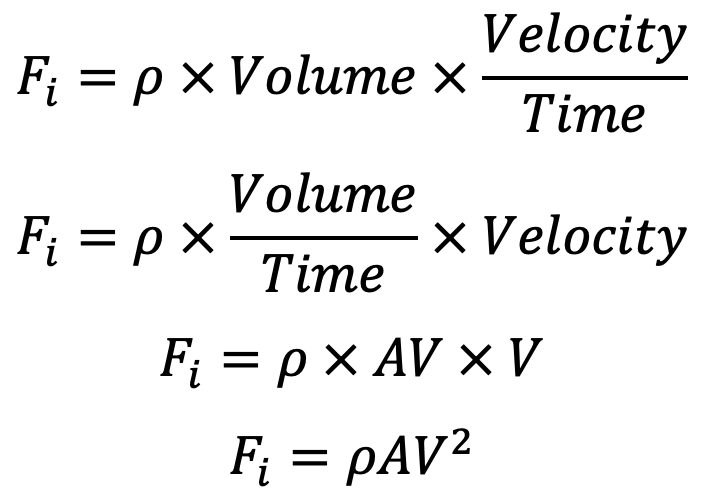
Viscous force (Fv) = Shear stress × Area
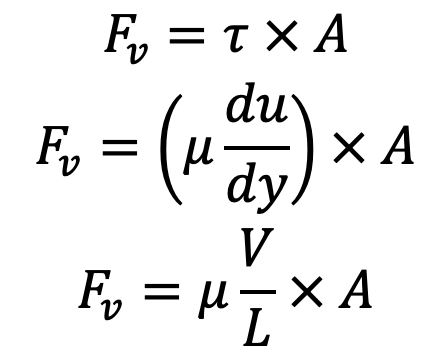
By definition, Reynold’s number,
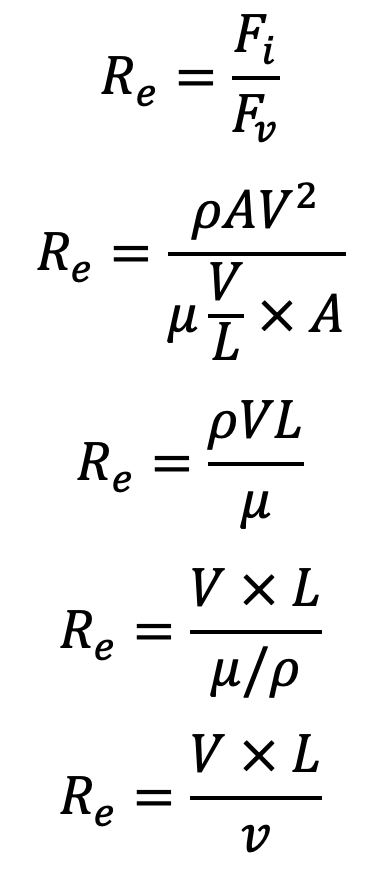
In the case of pipe flow, the linear dimension L is taken as diameter, d. Hence Reynold’s number for pipe flow,

We also discussed Reynold’s experiment. Check it out here.
2. Froude’s Number (Fe)
Froude’s number is defined as the square root of the ratio of the inertia force of a flowing fluid to the gravity force. Mathematically, it is expressed as
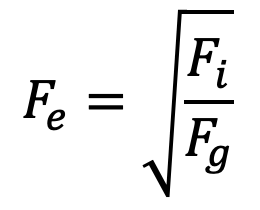
we know Fi is inertia force = ρAV2
Fg = Force due to gravity = Mass × Acceleration due to gravity = ρ × Volume × g = ρ × L3 × g
Fg = ρ × L2 × L × g
Fg = ρ × A × L × g
Substituting these Fi and Fg values in the above relation we get Froude’s Number
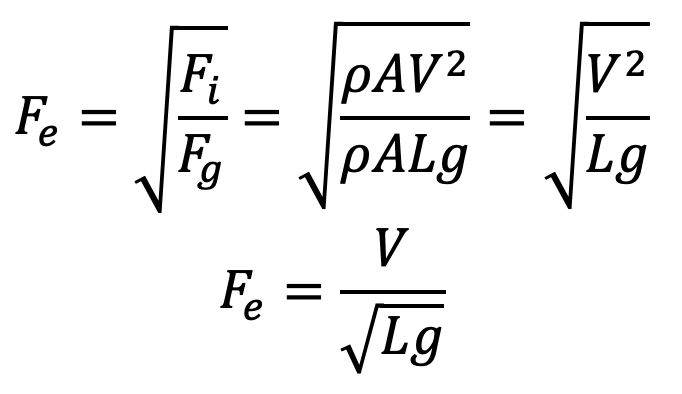
3. Euler’s Number (Eu)
It is defined as the square root of the ratio of the inertia force of a flowing fluid to the pressure force. Mathematically, it is expressed as
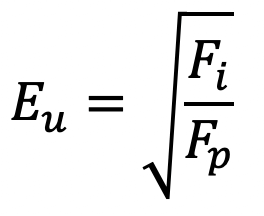
where
Fp = Intensity of pressure × Area = p x A
Fi = inertia force = ρAV2
Substituting these Fp and Fi values in the above relation we get Euler’s Number
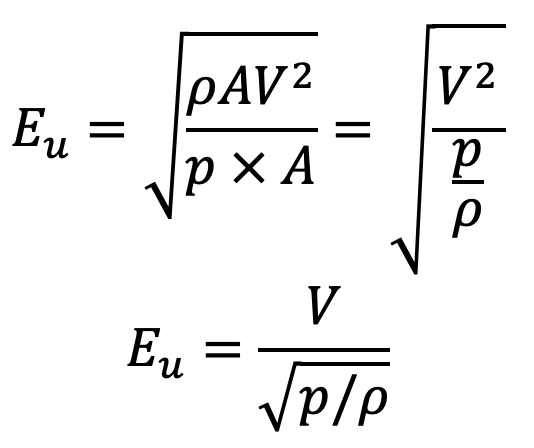
4. Weber’s Number (We)
It is defined as the square root of the ratio of the inertia force of a flowing fluid to the surface tension force. Mathematically, it is expressed as
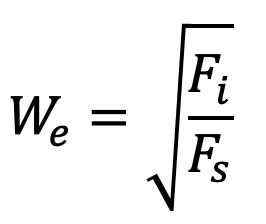
where
Fi = inertia force = ρAV2
Fs = Surface tension force = Surface tension per unit length × Length = σ × L
Substituting these Fi and Fs values in the above relation we get Weber’s Number
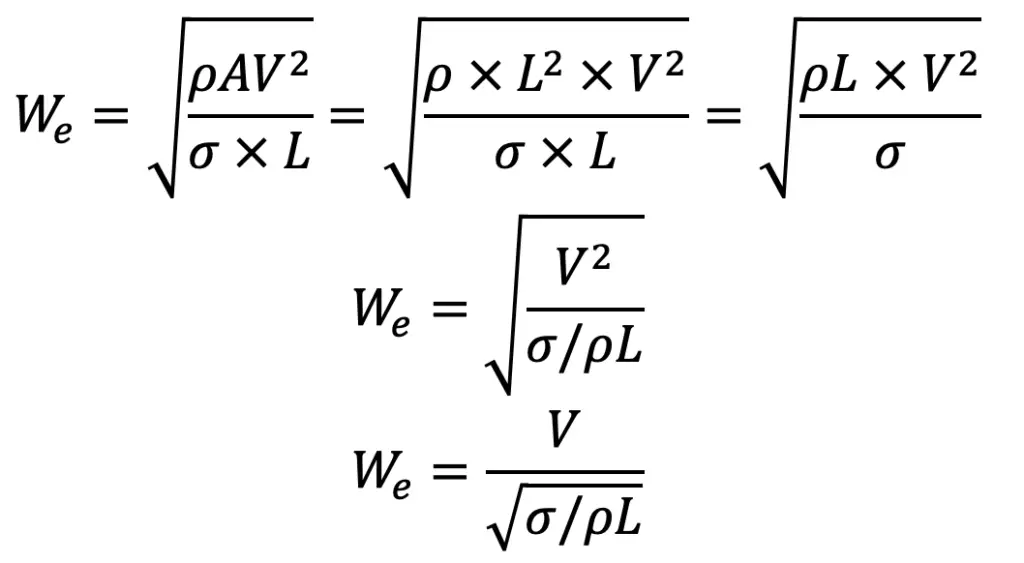
5. Mach’s Number (M)
Mach’s number is defined as the square root of the ratio of the inertia force of a flowing fluid to the elastic force. Mathematically, it is defined as

where
Fi = inertia force = ρAV2
Fe = Elastic force = Elastic stress × Area = K × A = K × L2
Substituting these Fi and Fe values in the above relation we get Weber’s Number
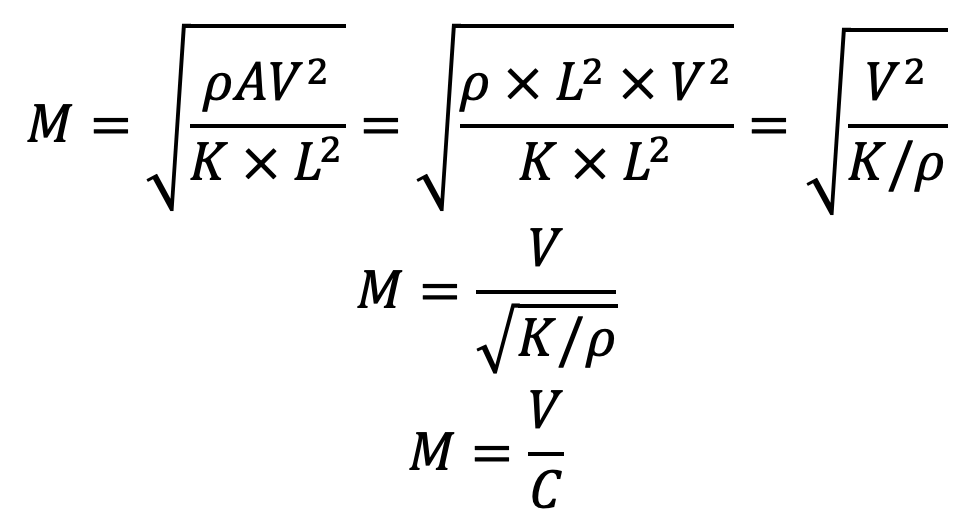
Dynamic Similarity Between Model and the Prototype
For the dynamic similarity between the model and the prototype, the ratio of the corresponding forces acting at the corresponding points in the model and prototype should be equal. The ratio of the forces is dimensionless numbers.
It means for the dynamic similarity between the model and prototype, the dimensionless numbers should be the same for the model and the prototype. But it is quite difficult to satisfy the condition that all the dimensionless numbers (i.e., Re, Fe, We Eu, and M) are the same for the model and prototype.
Hence models are designed on the basis of the ratio of the force, which is dominating in the phenomenon. The laws on which the models are designed for dynamic similarity are called model laws or laws of similarity.
Model Laws or Similarity Laws
The followings are the model laws:
- Reynold’s model law
- Froude model law
- Euler model law
- Weber model law
- Mach model law
1. Reynold’s Model Law
Reynold’s model law is the law in which models are based on Reynold’s number. Models based on Reynold’s number include:
- Pipe flow
- Resistance experienced by sub-marines, airplanes, fully immersed bodies etc.
As defined earlier the Reynold number is the ratio of inertia force and viscous force, and hence fluid flow problems where viscous forces alone are predominant, the models are designed for dynamic similarity on Reynolds law, which states that the Reynold number for the model must be equal to the Reynold number for the prototype.
Let
Vm = Velocity of fluid in the model
ρm = Density of fluid in the model
Lm = Length or linear dimension of the model
μm = Viscosity or fluid in the model
Similarly, Vp ρp Lp and μp are the corresponding values of velocity, density, linear dimension and viscosity of the fluid in the prototype. Then according to Reynold’s model law.
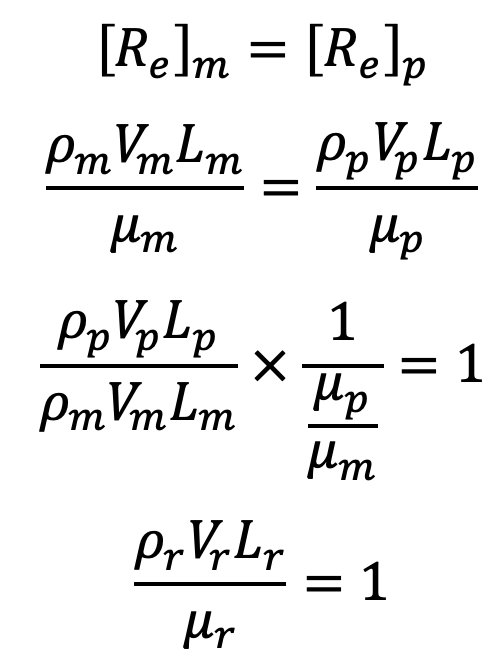
And also ρr, Vr, Lr, and μr are called the scale ratios for density, velocity, linear dimension, and viscosity.
The scale ratios for time, acceleration, force, and discharge for Reynold’s model law are obtained as
tr = Time scale ratio = Lr / Vr
ar = Acceleration scale ratio = Vr / tr
Fr = Force scale ratio = (Mass × Acceleration)r = mr × ar = ρr Ar Vr × ar = ρr Lr2 Vr × ar
Qr = Discharge scale ratio = (ρAV)r = ρr Ar Vr = ρr Lr2 Vr
2. Froude Model Law
Froude model law is the law in which the models are based on the Froude number which means for the dynamic similarity between the model and prototype, the Froude number for both of them should be equal. The Froude model law is applicable when the gravity force is only the predominant force which controls the flow in addition to the force of inertia. The Froude model law is applied in the following fluid flow problems:
- Free surface flows such as flow over spillways, weirs, sluices, channels etc.
- The flow of jet from an orifice or nozzle
- Where waves are likely to be formed on the surface,
- Where fluids of different densities flow over one another
Let
Vm = Velocity of fluid in the model
Lm = Linear dimension or length of model
gm = Acceleration due to gravity at a place where the model is tested.
Similarly, Vp, Lp and gp are the corresponding values of the velocity, length and acceleration due to gravity for the prototype. Then according to the Froude model law,
(Fe)Model = (Fe)Prototype
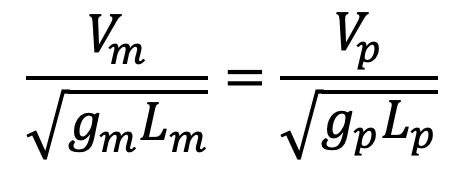
If the tests on the model are performed in the same place where the prototype is to operate, then gm = gp and the above equation becomes as
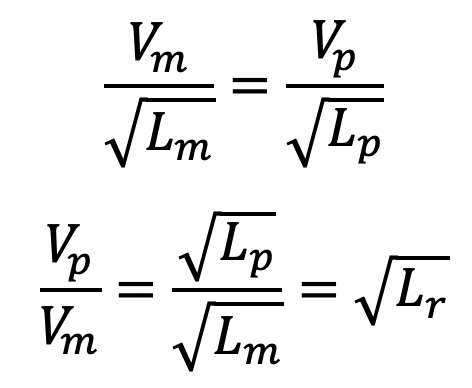
where
Lr = Scale ratio for length
Vp / Vm = Vr = Scale ratio for velocity
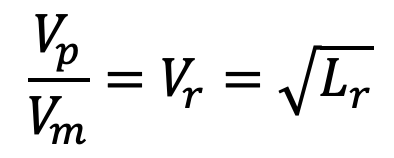
3. Euler’s Model Law
Euler’s model law is the law in which the models are designed on Euler’s number (Eu) which means for the dynamic similarity between the model and prototype, the Euler number for model and prototype should be equal. Euler’s model law is applicable when the pressure forces are alone predominant in addition to the inertia force.
According to this law
(Eu)model = (Eu)prototype
We know, Euler’s number
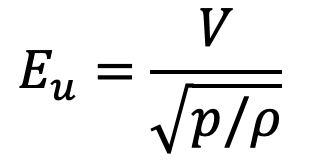
If
Vm = Velocity of fluid in the model,
Pm = Pressure of fluid in the model,
ρm = Density of fluid in the model,
Similarly, Vp, Pm, ρm = Corresponding values in the prototype
Substituting these values in equation (Eu)model = (Eu)prototype, we get
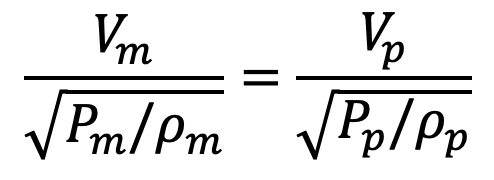
If the fluid is the same in model and prototype, then the above equation becomes as follows
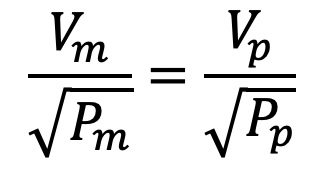
Euler’s model law is applied for fluid flow problems where flow is taking place in a closed pipe in
which case turbulence is fully developed so that viscous forces are negligible and gravity force and
surface tension force is absent. This law is also used where the phenomenon of cavitation takes place.
4. Weber Model Law
Weber model law is the law in which models are based on Weber’s number, which is the ratio of the square root of inertia force to surface tension force. Hence where surface tension effects predominate in addition to inertia force, the dynamic similarity between the model and prototype is obtained by equating the Weber number(We) of the model and its prototype.
Hence according to this law
(We)model = (We)prototype
Weber number is
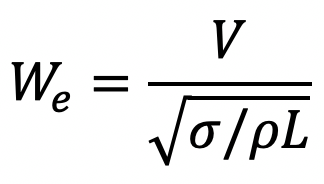
Vm = Velocity of fluid in model,
σm = Surface tensile force in model,
ρm = Density of fluid in model,
Lm = Length of surface in model,
Similarly, Vp, σp, ρp, Lp = Corresponding values of fluid in prototype
Then according to Weber law, we have

Weber model laws applied in the following cases:
- The capillary rise in narrow passages
- Capillary movement of water in the soil
- Capillary waves in channels
- Flow over weirs for small heads
5. Mach Model Law
Mach model law is the law in which models are designed on Mach number, which is the ratio of the square root of inertia force to the elastic force of a fluid. Hence where the forces due to elastic compression predominate in addition to inertia force, the dynamic similarity between the model and its prototype is obtained by equating the Mach number of the model and its prototype.
Hence according to this law:
(M)model = (M)prototype
We know the Mach number is
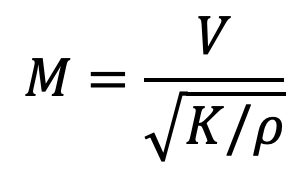
Vm = Velocity of fluid in model
Km = Elastic stress for model
ρm = Density of fluid in model
Similarly, Vp, Kp and ρp = Corresponding values for the prototype.
Then according to Mach’s law,
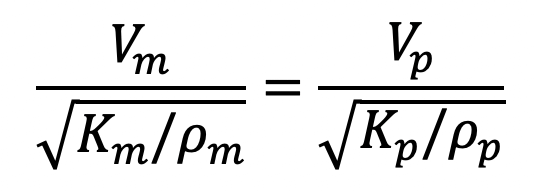
Mach model law is applied in the following cases:
- The flow of aeroplane and projectile through the air at supersonic speed, i.e., at a velocity more than the velocity of sound
- Aerodynamic testing
- Underwater testing of torpedoes
- Water-hammer problems.
These are the 5 model laws that help us determine the dynamic similarity between the model and the prototype, and the ratio of the corresponding forces acting at the corresponding points in the model and prototype. Let us know what you know about this article about Model Laws in the comment section below.

Leave a Reply